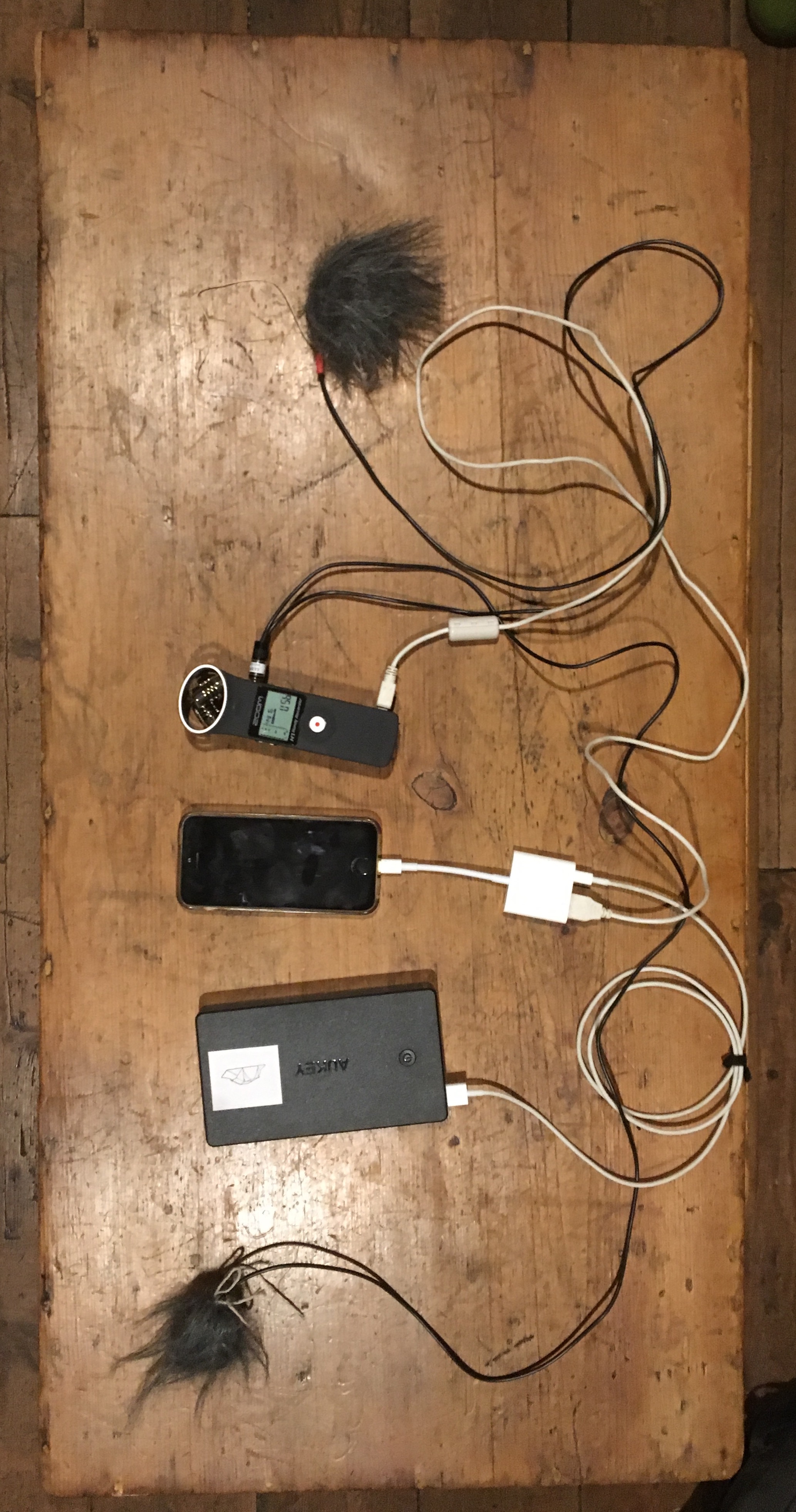

Start by opening an account to use the Locus Sonus streaming server. Go the login / new account page, then > open a new microphone. Save your settings. Your account will be quickly validated.
METHOD 1
Hardware
Iphone + Apple camera adapter (or clone) + Zoom H1n (or other recorder that works as a USB audio interface) + Primo microphones + Windscreen + Battery
Software
Locuscast - mobile app for iOS and Android by Locus Sonus
Notes
You can make a windscreen with a circle of synthetic fur gathered at the base with a reusable cable tie or a thread.
METHOD 2
Hardware
Android phone + On The Go (OTC) cable + Zoom H1n (or other recorder that works as a USB audio interface) + Primo microphones + Windscreen + Battery
Software
Locuscast mobile app for iOS and Android by Locus Sonus
or
Cool Mic streamer for Android (may work better for some models)
METHOD 3
Hardware
Laptop or desktop computer + soundcard (or a portable recorder that can provide an input / interface) + microphones
Software
Broadcast Using This Tool BUTT is a simple and good cross platform streamer - it's free. Contact us for settings.
METHOD 4
Hardware
Raspberry Pi (any model; especially suitable for Pi Zero if available or A+) + IQaudio Codec Zero + power source + data from a phone, 4G router, WiFi or wired connection + stereo microphones with minijack connector (you might have some or you can buy or make excellent microphones with Primo capsules) + Weatherproof housing.
Software
Download a disk image by Locus Sonus et al.
The 'unstable' version 4.0-dev is now tested and reliable. Choose the right one for you your Pi, as indicated by the link. Note that this IQaudio hat accepts a stereo input (contrary to the documentation). It works well with the Locus Sonus disk image and web interface, and is an excellent affordable low power streaming solution. Thanks to Udo Noll, Julian Weaver and others for work on this card.
Detailed build notes for a streambox based on this recipe.
METHOD 5
Hardware
Raspberry Pi (any model) + USB soundcard (eg Native Instruments Komplete Audio 2 for excellent sound quality, or any USB native soundcard which does not require proprietary drivers) + power source + data from a phone, 4G router, WiFi or wired connection + microphones (you might have some or you can buy or make excellent microphones with Primo capsules) + Weatherproof housing.
Software
Download a disk image by Locus Sonus et al for use with USB soundcards. The 'unstable' version 4.0-dev is now tested and reliable. Choose the right one for you your Pi, as indicated by the link.
METHOD 6
Hardware
Phone + Windscreen (sock, beanie) + Battery (maybe)
Software
Locuscast mobile app for iOS or Android by Locus Sonus
or
Cool Mic streamer for Android (may work better for some models)
Notes
How this sounds depends on the phone and the sounds around - varying from very good to not really useable. Experiment and listen to find a good location and reduce wind roar.
METHOD 7
Hardware
Phone + audio adaptor cable + Primo microphones + Windscreen + Battery (maybe)
Software
Locuscast mobile app for iOS or Android by Locus Sonus
or
Cool Mic streamer for Android (may work better for some models)
Notes
A TRS - TRSS adaptor cable such as the Rode SC4 can work well. It gives a dual mono input via the headphone jack. Some phones (possibly newer ones) can give interference (seemingly from the strong signal broadcast to the mobile network). There is no substitute for testing..
Some adapters from IK Multimedia, including legacy adapters work well, eg for providing a mono interface between iOS or Android devices and XLR microphones requiring phantom power (iRig pre).
Sign up for the broadcast and/or go ahead and set up a page for your stream. We will confirm when we will pick up your sounds. This will usually be around first light (start of Civil Twilight) on Saturday 30 April in the Western hemisphere, or Sunday 1 May in the Eastern hemisphere. The length of the segment will depend on how many other streamers are active in your timezone.
Set up a page for your stream, to give some context for listeners. These pages will be archived at soundtent.org.
Set up an account at Locus Sonus so your stream joins the server and appears on the soundmap.
We can provide advice and tech support. We can sometimes provide equipment. Tell us what you are planning.
See the 2021 Call for Streams - soon.
IN DEPTH
For setup and assembly of the latest steambox designed around the Focusrite USB soundcard, see this guide: Streambox (Focusrite version) . Or come to the London soundcamp and join a workshop.
To walk through setting up a Raspberry Pi streambox with the (now hard to find) Cirrus Logic soundcard), see these Pi Workshop Notes thanks to Balance Unbalance and V2 Lab for the Unstable Media.
Contact us for advice / support.
NOTES
This project is about live sound, rather than recording. (To share field recordings, explore the soundmap at radio aporee.)
Choosing a site, you may want to bear in mind the link with IDCD; but birdsong does not have to be a focus. Streams to date relayed sounds of wild boars, weather, VLF radiation, owls, self-noise, shrimps, cuckoos, air vents, hydrophones, radio intercepts, clocks, frogs. For more on soundcamps's broadly ecological concerns, see contexts.
Consider joining or setting up a dawn chorus event. IDCD for more information.
Once you're planning a stream, it doesn't take much to turn it into a soundcamp - which could be very small. For information, see the call for soundcamps - soon.
To tune into the programme or to to relay it > broadcast.